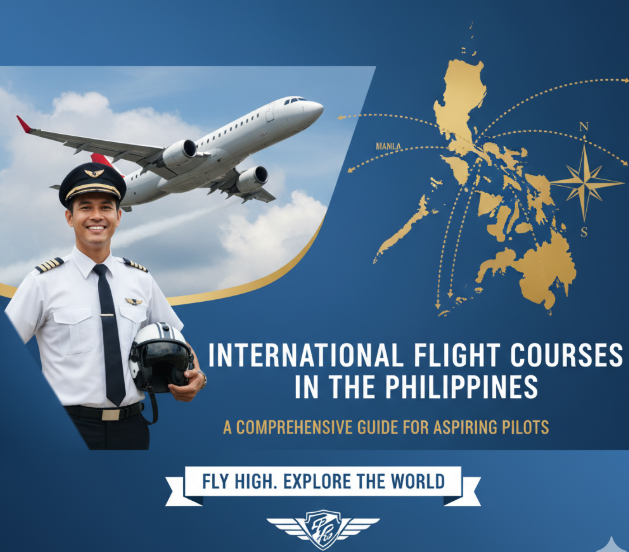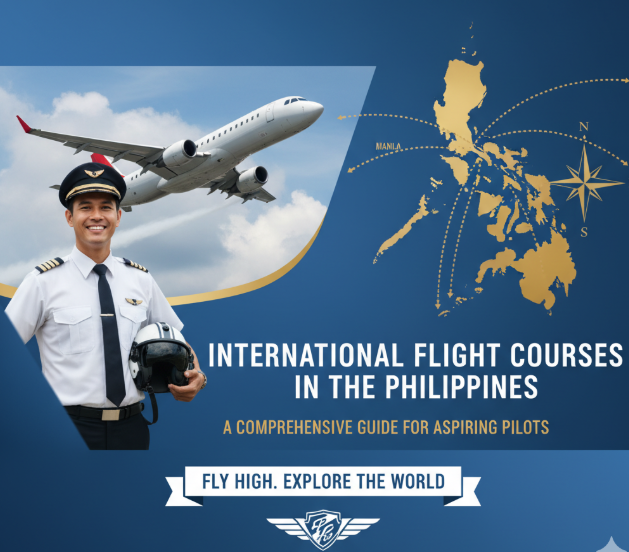
The aviation industry in the Philippines has grown rapidly in recent years, becoming an increasingly popular destination for students pursuing careers in flight. With its strategic location in Southeast Asia and its growing number of flight schools and aviation institutions, the Philippines has become a leading hub for international flight courses. This detailed guide explores everything aspiring pilots need to know about international flight courses in the Philippines, including eligibility, training, career opportunities, and the future of aviation in the country.
Introduction to International Flight Courses in the Philippines
International flight courses refer to comprehensive training programs designed to equip aspiring pilots with the skills and qualifications required to operate aircraft internationally. These programs typically include theoretical education, flight training, and examinations that lead to certifications recognized by global aviation authorities such as the International Civil Aviation Organization (ICAO) and the Civil Aviation Authority of the Philippines (CAAP).
In the Philippines, numerous aviation schools and institutes offer a variety of international flight courses, providing students with world-class training facilities, highly qualified instructors, and access to modern aircraft and flight simulators. These programs are designed not only to meet local aviation standards but also to prepare students for international flight operations, enhancing their prospects in the global aviation industry.
What Do International Flight Courses in the Philippines Entail?
Flight training in the Philippines generally involves several stages:
- Private Pilot License (PPL) – The first step in a pilot’s journey, the PPL is the foundation of flight training, enabling pilots to fly privately and operate small aircraft.
- Commercial Pilot License (CPL) – This license allows pilots to fly for compensation or hire, typically involving more advanced training and flight hours.
- Airline Transport Pilot License (ATPL) – This is the highest level of pilot certification, enabling pilots to serve as captains in commercial airlines.
- Flight Instructor Training – Aspiring flight instructors can also pursue specialized training to teach other student pilots.
Throughout each stage, students must undergo theoretical training in subjects such as navigation, meteorology, aviation law, aircraft systems, and air traffic control. Hands-on flight training is conducted using modern aircraft and flight simulators.
Importance of Aviation in the Philippines
Aviation is a vital industry in the Philippines, which is an archipelago composed of more than 7,000 islands. The country relies heavily on air travel for domestic and international transportation, trade, tourism, and defense. The Philippines has become an emerging player in the global aviation market, with its strategic location in Southeast Asia facilitating access to key international routes.
With increasing air traffic, the demand for qualified pilots has surged, creating a growing need for international flight training programs. The Philippine government has actively supported the development of aviation infrastructure, including modern airports and air traffic management systems, to ensure that the country remains a competitive player in the global aviation market.
Economic Impact of Aviation in the Philippines
Aviation contributes significantly to the Philippines’ economy, both in terms of employment and the facilitation of trade and tourism. The rise of budget airlines and the country’s reputation as a tourist destination have bolstered the demand for pilots and aviation professionals. Additionally, the Philippines is home to several international airlines, including Philippine Airlines, Cebu Pacific, and AirAsia Philippines, all of which require a steady supply of trained pilots.
History and Development of Aviation in the Philippines
The history of aviation in the Philippines dates back to the early 20th century, with the first successful flight occurring in 1910 when a Filipino aviator, Antonio Arnaiz, made a flight in a Wright Model B airplane. Since then, the country’s aviation industry has evolved, with significant milestones shaping its current landscape.
Early Aviation History in the Philippines
The Philippines was one of the early adopters of aviation technology in Southeast Asia. In 1928, the Philippine Air Lines (PAL) was founded, becoming the first airline in Asia and the world’s oldest continuously operating airline. Over the decades, the aviation sector expanded to include both domestic and international flights, with significant investments in airport infrastructure and aviation technology.
Milestones in Philippine Aviation
- 1948: Establishment of the Civil Aeronautics Administration (CAA), now known as the Civil Aviation Authority of the Philippines (CAAP), to oversee aviation operations in the country.
- 1960s-1970s: The introduction of jet aircraft and the expansion of international routes.
- 2000s: The rise of low-cost carriers, such as Cebu Pacific and AirAsia Philippines, revolutionized domestic and international air travel.
- Present Day: The Philippines continues to invest in aviation technology, including air traffic control systems, airport upgrades, and the development of new training programs for pilots.
Current Role of International Flight Courses in the Philippines
Today, international flight courses in the Philippines are pivotal in training the next generation of pilots, flight instructors, and aviation professionals. These courses provide students with internationally recognized certifications, enabling them to pursue careers with airlines, private aviation companies, and even government agencies.
The Philippines as a Leading Hub for Aviation Training
The Philippines has established itself as a top destination for international flight training, particularly for students from neighboring countries such as Japan, South Korea, and China. The combination of affordable tuition, high-quality training, and a favorable climate for year-round flying has made the country a popular choice for aspiring pilots.
In addition to training pilots for local airlines, many students from the Philippines travel abroad to work for international carriers, contributing to the global workforce of airline pilots. The growing demand for pilots worldwide further highlights the importance of flight training programs in the Philippines.
Eligibility, Training, and Skills Required
Basic Qualifications
To enroll in international flight courses in the Philippines, candidates must meet certain eligibility requirements:
- Education: A high school diploma or equivalent is required, but many students also have college degrees in fields such as engineering, aviation, or mathematics.
- Age: Candidates must be at least 17 years old to begin flight training. The maximum age may vary depending on the airline or training program, but most programs have an upper age limit of 35-40 years for initial training.
- Health: Applicants must pass a medical examination conducted by a Civil Aviation Medical Examiner. This ensures that the candidate is physically and mentally fit for flight training.
Technical & Soft Skills
In addition to meeting the basic qualifications, aspiring pilots must develop both technical and soft skills:
- Technical Skills: Knowledge of aviation systems, navigation, meteorology, aircraft maintenance, and aviation law is essential for flight training. These skills are honed through both classroom instruction and hands-on flight training.
- Soft Skills: Pilots must possess strong communication skills, leadership qualities, decision-making abilities, and the ability to work under pressure. These skills are critical for managing in-flight emergencies and maintaining safety.
Institutes, Academies, and Training Centers in the Philippines
The Philippines is home to several internationally recognized aviation institutes and flight schools that offer top-notch training programs. Some of the major aviation schools in the country include:
- Philippine Airline’s Aviation School – Founded by the national carrier Philippine Airlines, this institution offers a comprehensive training program for aspiring pilots, providing both ground school and flight training.
- Fly Higher Aviation – This school provides various programs, including Private Pilot License (PPL), Commercial Pilot License (CPL), and Airline Transport Pilot License (ATPL) courses.
- Cebu Pacific Flight Academy – One of the leading flight schools in the Philippines, offering both ab initio training and advanced programs for students aspiring to become professional pilots.
- ATC (Aviation Training Center) Philippines – Known for its world-class flight simulators and aircraft, ATC offers a variety of training programs, from PPL to CPL and beyond.
- Philippine State College of Aeronautics (PhilSCA) – A government-run institution offering comprehensive aviation degrees and pilot training programs.
Government Initiatives
The Philippine government supports aviation education through regulatory bodies like the Civil Aviation Authority of the Philippines (CAAP), which ensures that aviation schools comply with safety standards and training regulations. Additionally, initiatives to improve airport infrastructure, air traffic management, and aviation technologies further support the growth of the aviation sector.
Technology and Innovation in Aviation Training
As aviation technology advances, training programs in the Philippines are incorporating innovative tools such as flight simulators and AI-driven cockpit systems. Modern flight simulators provide students with realistic in-flight experiences, allowing them to practice emergency scenarios and flight procedures in a controlled environment.
In addition, advancements in digital cockpits and spacecraft navigation are being integrated into training programs to prepare students for the next generation of aviation technologies.
Global Agencies and Their Impact
Agencies like NASA, ISRO, and the European Space Agency (ESA) are pushing the boundaries of space exploration and advanced aviation technologies. These innovations, such as AI in flight training and the development of space tourism, are influencing aviation education worldwide, including in the Philippines.
Challenges Faced in Pilot Training in the Philippines
While the Philippines offers a promising environment for flight training, there are still several challenges to address:
- Infrastructure Gaps: Despite ongoing improvements, some aviation schools still face limitations in terms of modern aircraft and simulators.
- Costs: The cost of flight training can be prohibitive for many students, particularly those from lower-income backgrounds.
- Regulatory Hurdles: Navigating the complex regulatory requirements for pilot certifications can be a challenge for both students and training institutions.
- Brain Drain: Many highly trained pilots leave the Philippines for better job opportunities abroad, creating a shortage of qualified pilots in the country.
Future of International Flight Courses in the Philippines
The future of international flight courses in the Philippines looks promising. With advancements in aviation technology, such as AI-driven flight simulators and space tourism, pilot training will continue to evolve. Additionally, national projects like India’s Gaganyaan and China’s lunar exploration initiatives are likely to influence the future of aviation training in the Philippines.
Space Tourism and Private Aviation
As space tourism gains momentum, new opportunities for pilots to train in space-related aviation programs are emerging. The Philippines, with its growing aviation infrastructure, is well-positioned to contribute to this exciting field.
Career Path & Opportunities
The career path for an aspiring pilot in the Philippines typically follows these steps:
- Education: Complete the necessary education requirements, including high school and college (if applicable).
- Pilot License: Obtain a Private Pilot License (PPL), followed by a Commercial Pilot License (CPL) and, eventually, an Airline Transport Pilot License (ATPL).
- Advanced Training: Gain specialized training in various areas such as flight instructing, multi-engine aircraft operations, or even spaceflight.
- Employment: Upon completing the necessary training, pilots can apply to airlines, charter companies, or space programs for employment.
Salary Expectations and Global Scope
While pilot salaries in the Philippines vary based on experience and the employer, global demand for pilots ensures that trained professionals have a wide range of international career opportunities. Pilots trained in the Philippines can work for international airlines or enter specialized fields like space exploration or flight instruction.
FAQs (Frequently Asked Questions)
- How much does pilot training cost in the Philippines?
- Which is the best aviation institute in the Philippines?
- What qualifications are needed for pilot training in the Philippines?
- Is international flight training available in the Philippines?
- What is the future of aviation in the Philippines?
Conclusion / Final Thoughts
Aviation careers in the Philippines offer great potential for students interested in pursuing a dynamic and rewarding profession. With world-class training programs, advanced technology, and a growing industry, the Philippines continues to be a top destination for aspiring pilots. Whether you’re looking to join a commercial airline, become a flight instructor, or even explore the possibilities of space tourism, the opportunities in the Philippine aviation sector are abundant.
